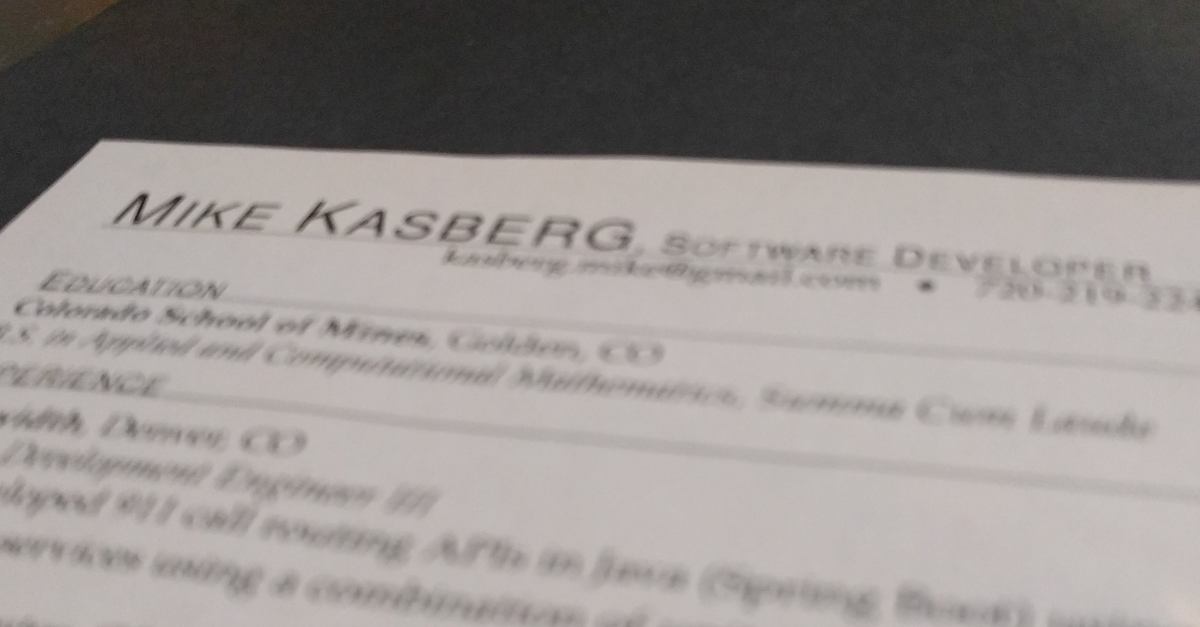
Tips for a Great Resume
Your resume says a lot about you. Perhaps more than you think. I’ve looked at a fair amount of resumes and when I read a resume, I’m not only interested in the experience that’s listed. I also look at how well the person communicates their ideas in a clear and concise format. A well written and easy-to-read resume can make a good first impression, and a poorly written resume can definitely hurt you.
Based on my experience - both reading resumes and writing my own - I’ve come up with some simple tips to help you make sure your resume looks great and avoid some pitfalls. And while my experience is centered around software engineering, most of these tips will apply to other fields equally well.
Keep it to a page
When I interview someone, it’s actually a bit of a red flag for me if their resume is longer than a single page. It tells me that they don’t know how to filter out unimportant information and summarize the most important ideas. Also, it’s not uncommon for me to have to skim through several resumes at once. And when I’m skimming, I don’t always have time to read all 5 pages, so sometimes I only look at the first page anyway. While there are always exceptions, most people will be better off with a single-page resume.
If your resume’s longer than a single page, consider what’s really relevant to the job you’re applying for. Are the oldest items on your resume still relevant? Can some details be removed there? Also, consider removing details from more recent work if the information isn’t applicable to the position you’re applying for.
Make it look a little unique (but keep it formal)
You want your resume to look like you put some time, thought, and effort into it. Using Times New Roman with bold headings does none of these things. You probably won’t be eliminated for using the default MS Word font, but you won’t stand out either. Essentially, you want to show your interviewer that you care enough about your resume to make it look nice. Experiment with different fonts and font sizes, and let your personality come out a little. A well-chosen monospaced font can be a nice touch on a programmer’s resume. Both serif and sans-serif fonts are OK, but make sure they look professional (not Comic Sans!). Consider using a different font for your name or for headings throughout the resume. If done well, this can help separate your headings from the rest of the content, making your resume more readable.
Make sure it’s easy to skim
Speaking of readability, it’s not uncommon for an interviewer to have to look through 5, 10, or even 20 resumes in a short amount of time. Make it easy for your interviewer to find the information they’re looking for quickly. Make sure different sections (like Education, Experience, and Skills) can be found at a glance. And it should be easy to quickly skim job titles, companies, and dates. Consistent formatting is the biggest factor that can improve (or hinder) readability. If your dates are right-aligned in the Education section, they should also be right-aligned in the Experience section.
Don’t be sloppy
On the surface, it seems pretty easy (and obvious) to make sure your resume doesn’t look sloppy. Don’t use square bullets in one section and round bullets in another. Don’t use list numbers in one section and list letters in another. Don’t highlight a couple too many characters when you hit the italics button.
In addition to the obvious stuff, make sure that MS Word (or whichever program you’re using) lines things up the right way. In resumes, it’s pretty common to have left-aligned and right-aligned text on the same line. Don’t use spaces to separate left-aligned text from right-aligned text on the same line. There’s a proper way to do it, and it looks bad when you don’t (because the right edge won’t line up exactly).
In Conclusion
There are articles all over the internet with resume basics and sample layouts. I hope these tips go a little bit deeper than that, and inspire you to create a great-looking and highly functional resume for your next job search.
About the Author

👋 Hi, I'm Mike! I'm a husband, I'm a father, and I'm a staff software engineer at Strava. I use Ubuntu Linux daily at work and at home. And I enjoy writing about Linux, open source, programming, 3D printing, tech, and other random topics. I'd love to have you follow me on X or LinkedIn to show your support and see when I write new content!
I run this blog in my spare time. There's no need to pay to access any of the content on this site, but if you find my content useful and would like to show your support, buying me a coffee is a small gesture to let me know what you like and encourage me to write more great content!
You can also support me by visiting LinuxLaptopPrices.com, a website I run as a side project.
Related Posts
- 6 Questions to Ask When You Interview for a Software Development Position 25 Apr 2018
- Make Your Source Code Developer-Friendly 19 Aug 2018
- Testing is Hard 28 Jan 2017